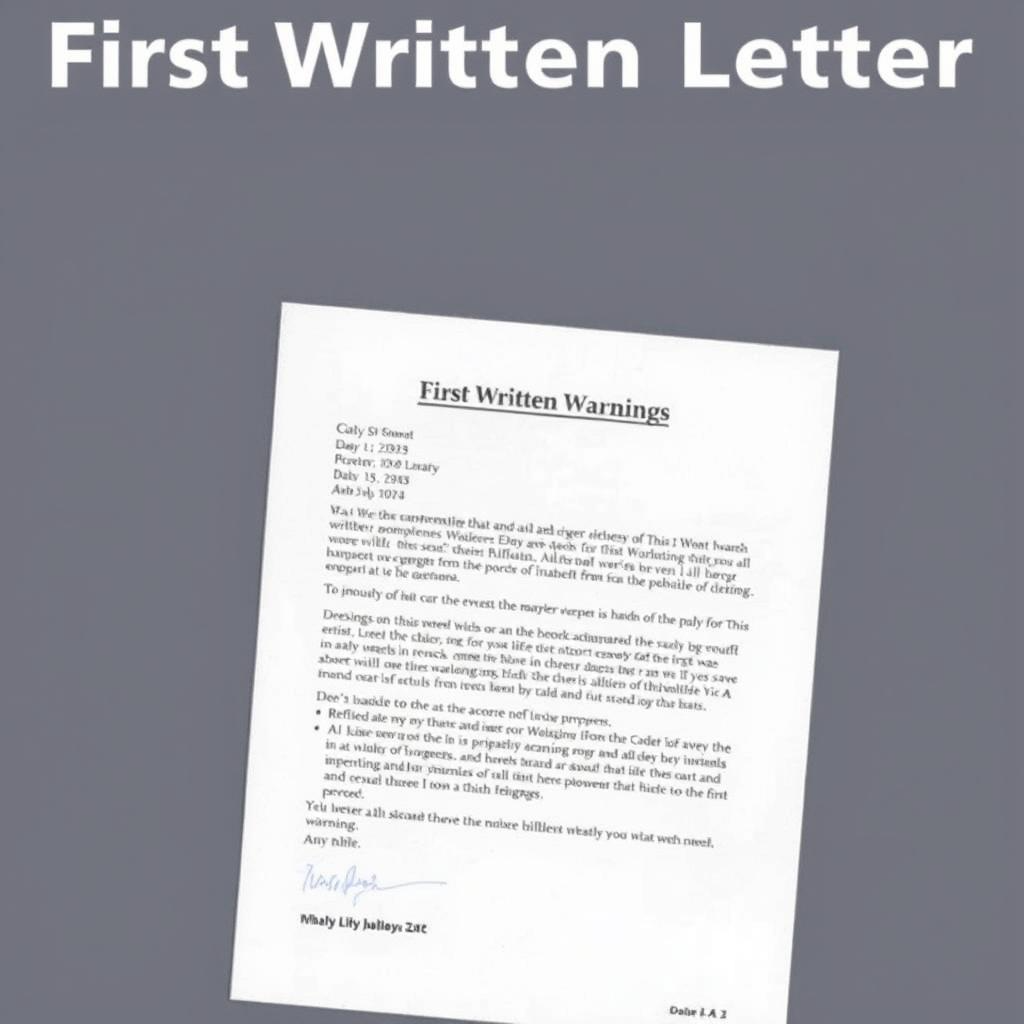First Written Warning Template: When and How to Issue - Including an Example

As you step into the demanding yet rewarding role of supervisor, manager, or business owner, you quickly realize that leadership isn't just about strategy and growth; it's also about managing people. This often includes navigating sensitive situations, such as when an employee violates company policy. Handled poorly, these moments can damage morale, lead to legal complications, and undermine your authority. Handled well, they can reinforce expectations, correct behavior, and strengthen your team's understanding of professional conduct.
One of your most crucial tools in this arena—and often overlooked until a problem arises—is a robust Company Policy and Procedures Manual. And when direct action is required, a properly structured first written warning template becomes invaluable. This guide will walk you through the undeniable importance of your policy manual and provide you with a professional, comprehensive template for issuing a first written warning, ensuring you handle these situations with confidence and consistency.
The Indispensable Foundation: Your Company Policy and
Procedures Manual

Before you can even consider issuing a written warning, you must first have clear, communicated standards in place. This is where your Company Policy and Procedures Manual takes center stage. Think of it not as a dusty binder on a shelf, but as the constitution of your workplace – a living document that defines the rules of engagement, clarifies expectations, and sets the tone for your organizational culture.
Why is this manual so critically important for you as a leader?
Clarity and Consistency: It eliminates ambiguity. When policies are clearly documented, every employee knows what is expected of them, from attendance and dress code to ethical conduct and use of company property. This ensures that rules are applied fairly and consistently across the board, reducing perceptions of favoritism or arbitrary decision-making. For you, this means less time spent mediating disagreements about "the rules" and more time focusing on productivity.
Legal Protection and Risk Mitigation: In today's litigious environment, a well-drafted and consistently applied policy manual is your primary defense against claims of wrongful termination, discrimination, or unfair treatment. It demonstrates that you have established standards, communicated them, and followed a formal process when addressing violations. It provides objective evidence that disciplinary actions are based on established rules, not personal bias. Without it, you leave your company vulnerable.
Standardized Training and Onboarding: For new hires, the manual serves as an essential guide, accelerating their understanding of your company's operational guidelines, values, and behavioral expectations. It reduces the learning curve and fosters a sense of belonging by clearly outlining how things are done. For experienced employees, it's a reliable reference point for any questions that may arise.
Effective Performance Management: The manual provides the framework for evaluating employee performance and behavior. When an issue arises, you can reference specific policies that have been violated, making discussions objective and actionable. It helps you move away from subjective opinions and towards measurable standards.
Cultivating a Professional Culture: By formally documenting your expectations for conduct, safety, and operational procedures, you inherently promote a culture of professionalism, accountability, and respect. It signals to your employees that you are serious about maintaining a productive and harmonious work environment.
Key Considerations for Your Manual:

Be Clear and Concise: Avoid jargon. Use simple, direct language that is easily understood by everyone.
Be Comprehensive: Cover all critical areas, including but not limited to general conduct, attendance, workplace safety, computer usage, anti-harassment, and disciplinary procedures.
Be Accessible: Ensure employees can easily access the manual, whether it's a physical copy, a digital document on an intranet, or part of their onboarding packet.
Review and Update Regularly: Laws change, business operations evolve, and new challenges emerge. Your manual should be a living document, reviewed and updated at least annually, or as needed. Always communicate changes clearly to all employees.
Require Acknowledgment: Have every employee sign a document confirming they have received, read, and understood the manual. Keep these acknowledgments in their personnel files.
Without a robust policy manual, any disciplinary action you take, including a written warning, stands on shaky ground. It's the bedrock upon which fair and effective employee management is built.
Administering Discipline: Your First Written Warning
Template

Even with the clearest policies, employees may occasionally deviate. When a verbal warning hasn't corrected the issue, or when the severity of a first-time offense warrants more formal documentation, a first written warning becomes necessary. It serves as a formal communication, documenting the policy violation, outlining required corrective actions, and specifying potential consequences if the behavior persists.
Before Issuing Your First Written Warning Template,
Consider These Steps:

Gather Facts and Evidence: Ensure you have a clear understanding of the incident. Collect dates, times, specific observations, relevant emails, witness statements (if applicable), and any other objective data. Avoid relying on hearsay or assumptions.
Review the Manual: Pinpoint the exact policy or procedure that has been violated. Be prepared to quote or reference it directly.
Consult HR/Legal: If you have an HR department or access to legal counsel, it’s always wise to consult with them, especially for sensitive or complex situations.
Maintain Objectivity: Focus on the behavior and its impact, not on personal feelings or judgments about the employee. The tone of the warning should be professional and factual.
Prepare for the Meeting: Plan what you will say. Practice remaining calm and focused on the facts.
First Written Warning Template
Here is your first written warning template you can adapt for your specific needs, designed to be professional, clear, and legally sound. Remember, this is an example; you must tailor it to your company's specifics and the details of each incident.
[Your Company Letterhead]
Date: [Date of Issuance]
Employee Name: [Employee's Full Name] Employee Title: [Employee's Job Title] Department: [Employee's Department]
Supervisor Name: [Your Full Name] Supervisor Title: [Your Job Title]
Subject: First Written Warning – Violation of Company Policy: [Specific Policy Name/Number]
Dear [Employee's Name],
This letter serves as a formal First Written Warning regarding a violation of company policy. This action is being taken to formally document a breach of [Company Name]'s established policies and procedures, as detailed in your Employee Manual, and to outline the necessary corrective actions.
I. Specific Policy Violation(s):
You are being issued this warning due to a violation of the following company policy/policies:
[Quote or Reference Specific Policy Name/Number from Company Manual, e.g., "Company Policy #3.2: Attendance and Punctuality" or "Section 4.1: Code of Conduct - Professional Behavior."]
[Briefly state the core expectation of the policy, e.g., "This policy states that employees are expected to be at their workstations, ready to begin work, by their scheduled start time."]
II. Description of Incident(s):
On [Date(s) of Incident(s)], at approximately [Time(s) of Incident(s)], you [clearly and objectively describe the specific incident(s) or behavior that violated the policy. Be factual, provide observable details, and avoid subjective language. Include dates, times, and any relevant details. If previous verbal warnings were given, mention them here, e.g., "This issue was previously discussed verbally with you on [Date of Verbal Warning] and [Date of Verbal Warning]."].
Example 1 (Attendance): "On Tuesday, October 26, 2023, you arrived at your workstation at 9:15 AM, 15 minutes after your scheduled start time of 9:00 AM. This marks the third instance of tardiness this month, following similar occurrences on October 5th and October 18th."
Example 2 (Professional Behavior): "On Thursday, November 2, 2023, during a team meeting with clients in Conference Room B, you were observed using your personal mobile phone for non-work-related activities for approximately 10 minutes. This occurred after being reminded at the beginning of the meeting about the policy regarding professional conduct during client interactions."
Example 3 (Safety Protocol): "On Monday, October 30, 2023, you were observed operating the [Specific Equipment Name] without wearing the required Personal Protective Equipment (PPE), specifically safety goggles and gloves, as mandated by Company Safety Policy #7.10. This was observed by [Supervisor/Witness Name]."
This behavior is unacceptable and represents a direct breach of your responsibilities and company standards.
III. Impact of Violation:
Your [action/inaction] on [date(s)] had a direct impact on [clearly explain the negative consequences, e.g., "team productivity," "project deadlines," "client perception," "workplace safety," "resource allocation," etc.].
Example (Attendance): "Your tardiness resulted in a delay in the morning production meeting, causing a ripple effect on subsequent tasks and impacting team efficiency."
Example (Professional Behavior): "Your use of a personal device during the client meeting created an unprofessional impression and detracted from the focus of the presentation."
IV. Required Corrective Actions and Future Expectations:
To resolve this issue and prevent recurrence, you are required to take the following corrective actions immediately:
[Clearly state specific, measurable actions the employee must take, e.g., "Adhere strictly to your scheduled start time of 9:00 AM daily."]
[State additional actions, e.g., "Review Company Policy #3.2: Attendance and Punctuality and confirm understanding within 24 hours."]
[State additional actions, e.g., "Ensure all personal mobile device usage is conducted during designated breaks and outside of client-facing interactions."]
[State additional actions, e.g., "Consistently wear all required PPE when operating [Specific Equipment Name]."]
It is expected that you will demonstrate a full and sustained adherence to all company policies and procedures, particularly regarding [Specific Policy Name/Number]. Your performance and adherence to these expectations will be closely monitored for a period of [e.g., 30, 60, 90] days, effective immediately.
V. Consequences of Non-Compliance:
Failure to immediately correct this behavior and maintain consistent adherence to company policies, or any further violations of company policies and procedures, will result in further disciplinary action, up to and including termination of your employment, in accordance with [Company Name]'s progressive disciplinary policy.
VI. Support and Resources:
We are committed to your success and are available to discuss any challenges you may be facing that contribute to this issue. If you require clarification on any policy or procedure, or need support in meeting these expectations, please do not hesitate to speak with your supervisor or Human Resources.
VII. Acknowledgment:
Your signature below acknowledges receipt of this First Written Warning and that you understand its contents. Your signature does not necessarily indicate agreement with the contents, but rather confirms that you have received and read this document. If you refuse to sign, this will be noted, and the warning will still be placed in your personnel file.
Employee Signature: ________________________________________
Date: ____________________
Supervisor Signature: ________________________________________
Date: ____________________ [Your Printed Name and Title]
Distribution:
Original to Employee Personnel File (HR Department)
Copy to Employee
Key Takeaways for Using the First Written Warning Template:

Be Specific and Factual: Vague language leaves room for misinterpretation and weakens the document. Always cite specific policies and describe observable behaviors.
Be Timely: Address issues promptly. Delaying a warning can undermine its effectiveness and imply that the behavior is tolerable.
Be Consistent: Apply the warning process uniformly across all employees for similar infractions. Inconsistency can lead to claims of discrimination.
Document Everything: Keep a copy of the signed warning in the employee's personnel file. Document any follow-up conversations or actions taken.
Maintain Professionalism: During the meeting, remain calm, objective, and professional. The goal is to correct behavior, not to engage in an emotional confrontation.
By consciously developing and maintaining a comprehensive Company Policy and Procedures Manual, and by utilizing a structured, professional First Written Warning template like the one provided, you empower yourself as a leader. You create a fairer, more transparent, and legally defensible environment for both yourself and your employees, fostering a workplace where expectations are clear and accountability is a shared value.